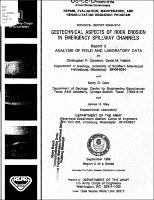Please use this identifier to cite or link to this item:
https://hdl.handle.net/11681/4426Full metadata record
| DC Field | Value | Language |
|---|---|---|
| dc.contributor | University of Southern Mississippi. Department of Geography and Geology | - |
| dc.contributor | Texas A & M University | - |
| dc.contributor | Repair, Evaluation, Maintenance, and Rehabilitation Research Program (U.S.) | - |
| dc.contributor.author | Cameron, Christopher P. | - |
| dc.contributor.author | Patrick, David M. | - |
| dc.contributor.author | Cato, Kerry Don, 1959- | - |
| dc.contributor.author | May, James H. | - |
| dc.date.accessioned | 2016-03-16T21:52:07Z | - |
| dc.date.available | 2016-03-16T21:52:07Z | - |
| dc.date.issued | 1988-09 | - |
| dc.identifier.uri | http://hdl.handle.net/11681/4426 | - |
| dc.description | Technical report | - |
| dc.description | Abstract:Field and laboratory studies of erosion in unlined emergency spillways channels excavatedin rock have demonstrated that erosional processes operating in these spillway channels are similar to those operating in natural stream channels and that rock discontinuities are critical factors in the initiation and extent of erosion. Knickpoint formation and headcutting are typical erosion processes. Fractures, faults, joints, dip orientation, igneous contacts, veins, bedding planes, unconformities, bed pinch outs, and facies changes are types of structural or stratigraphic discontinuities which must be characterized if present. The analysis of 14 Soil Conservation Service and 2 Corps of Engineers dams which have experienced emergency spillway flow revealed that the extent of erosion at these sites could be categorized in terms of volumetric and horizontal erosion rankings. These ranking parameters provide insight as to the seriousness of the erosion threat at a particular dam and may-be used to give priority for remediation. Generally, the ranking parameters were more closely correlatable with the geometry of the spillway channel than with the hydraulics of the spillway flow event. Preliminary laboratory studies using a recirculating, tilting flume and simulated earth materials configured as a knickpoint (waterfall) demonstrated that maximum undermining and erosion of a stratified, two-layer system was a function of the ratio of water depth to knickpoint height and the venting condition of the waterfall. The maximum erosion did not occur at peak discharge but occurred when the discharge passed through windows or thresholds on the rising and falling limbs of the hydrograph which were, in turn, controlled by the ratio (above) and venting. These field and laboratory investigations have substantiated the need for detailed geological information at sites experiencing spillway flow, detailed documentation of the results of spillway flow, and model studies in which spillway geometries are evaluated in terms of geology and nature and spacing of discontinuities. | - |
| dc.publisher | Geotechnical Laboratory (U.S.) | - |
| dc.publisher | Engineer Research and Development Center (U.S.) | - |
| dc.relation | http://acwc.sdp.sirsi.net/client/en_US/search/asset/1041727 | - |
| dc.rights | Approved for public release; distribution is unlimited. | - |
| dc.source | This Digital Resource was created from scans of the Print Resource. | - |
| dc.subject | Channel | - |
| dc.subject | Erosion | - |
| dc.subject | Geology | - |
| dc.subject | Headcutting | - |
| dc.subject | Knickpoint | - |
| dc.subject | Spillway | - |
| dc.title | Geotechnical aspects of rock erosion in emergency spillway channels. Report 2, Analysis of field and laboratory data | - |
| dc.type | Report | en_US |
| Appears in Collections: | Technical Report | |
Files in This Item:
| File | Description | Size | Format | |
|---|---|---|---|---|
| TR-REMR-GT-3-Report-2.pdf | 2.4 MB | Adobe PDF |  View/Open |